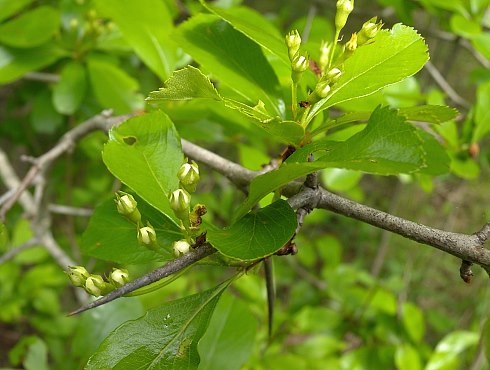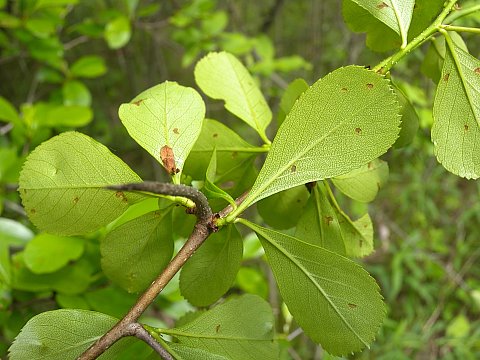
Corymbs (flat-headed panicles) of flowers about 2-3" across are produced from some of the leaf axils. The branching peduncle and pedicels of the corymbs are light green and glabrous. Each flower is up to ½" across, consisting of 5 white spreading petals, a short green calyx with 5 teeth, 10 stamens (rarely up to 20) with either pale yellow or pink anthers, and a pistil with 2-3 styles. The calyx is glabrous and its teeth are linear-lanceolate with smooth margins. The blooming period occurs from late spring to early summer, lasting about 7-10 days. The flowers have an unpleasant scent. Fertile flowers are replaced by globoid pomes up to ½" across that become red at maturity. Each pome contains 1-3 seeds; its flesh is somewhat dry and bitter. The pomes often persist into the winter. The deciduous leaves turn red or yellow during autumn.

Cultivation: The preference is full sun, mesic to dry conditions, and soil containing loam, clay, or rocky material. Cockspur Hawthorn is vulnerable to hawthorn-rust and other disease organisms.
Range & Habitat: The native Cock-Spur Hawthorn is occasional to locally common in most areas of Illinois, except the NW section of the state, where it is uncommon or absent (see Distribution Map). Habitats consist of open upland woodlands, rocky woodlands, upland savannas, thickets, limestone glades, fence rows, areas along railroads, roadsides, and abandoned fields. This shrub (or small tree) is a pioneer species that colonizes open areas where competition from other woody vegetation has been reduced.

Faunal Associations: The nectar and pollen of the ill-smelling flowers attract a variety insects, including honeybees, bumblebees, Halictid bees, masked bees (Hylaeus), Andrenine bees, Sphecid wasps, Vespid wasps, Syrphid flies, dance flies (Empididae), Calliphorid flies, butterflies, and beetles (Robertson, 1929). Other insects use Cockspur Hawthorn and other hawthorn trees (Crataegus spp.) as a source of food by consuming their wood, leaves, flowers, fruits, and plant sap. This latter group of insects includes the larvae of metallic wood-boring beetles, larvae of long-horned beetles, leaf beetles, weevils, larvae of gall flies, plant bugs, aphids, leafhoppers, treehoppers, scale insects, larvae of sawflies, larvae of many moths, and larvae of the butterfly, Red-spotted Purple (Limenitis arthemis astyanax). The Insect Table has a more complete list of these species. Some birds use the crabapple-like fruits as a source of food, by which means they spread the seeds of hawthorn trees considerable distances. These birds include the Wood Duck, Northern Cardinal, Blue Jay, Fox Sparrow, Gray Catbird, Northern Mockingbird, Hermit Thrush, American Robin, Northern Flicker, Bobwhite Quail, Wild Turkey, Ring-necked Pheasant, and Ruffed Grouse. The latter bird also feeds on the buds and young leaves of these trees (see the Bird Table for a more complete list of these bird species). Because the Cockspur Hawthorn and other hawthorn trees are often densely branched and thorny, they provide ideal protective cover and nesting sites for many species of birds, including the Common Grackle, Willow Flycatcher, and Field Sparrow (Homan et al., 1996; DeGraaf, 2002; Best, 1978). Mammals also use these small trees as a source of food and protective cover. Mammals that consume the fruits include the Gray Fox, Woodland Vole (Microtus pinetorum), Striped Skunk, and American Black Bear. During the winter, the American Moose and White-tailed Deer browse on the twigs and fruits, while the Cottontail Rabbit gnaws on the bark (Martin et al., 1951/1961; Ludewig & Bowyer, 1985). Snags and cavities of hawthorn trees provide occasional roost sites for the Northern Long-eared Bat (Myotis septentrionalis); see Carter (2003).

Photographic Location: An open woodland on a bluff along the Maumee River in NW Ohio, and along the edge of Busey Woods in Urbana, Illinois.
Comments: Because of its distinctive oblanceolate leaves, this is one of the easiest hawthorns (Crataegus spp.) to identify. Wild forms of Cockspur Hawthorn are exceptionally thorny, but there is a spineless form in cultivation. At one time, this shrub (or small tree) was divided into several species on the basis of minor differences in the floral structure, leaf shape, thorniness, or fruiting characteristics, but they are presently considered variations of the same species by most authorities.